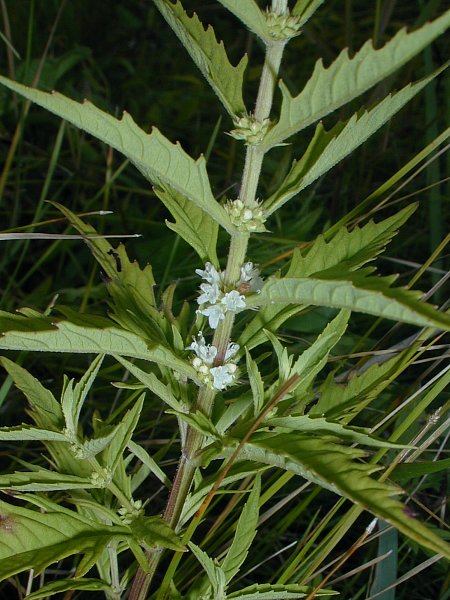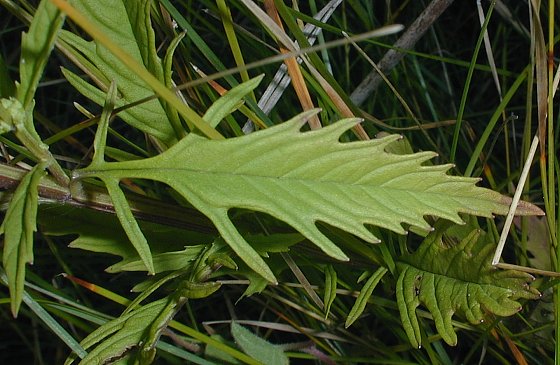Description: This perennial plant is about 1-3' tall; it is usually unbranched, otherwise branching sparingly. The green or reddish central stem is four-angled and ridged; it may be hairless or slightly pubescent. This plant has a tendency to sprawl in the absence of supportive vegetation. The opposite leaves are spaced somewhat widely along the stems; they are sessile or short-petioled. The leaf blades are up to 3" long and ¾" across; they are lanceolate, ovate-lanceolate, or elliptic-lanceolate in shape. The lower leaves are narrowly lobed or pinnatifid toward their bases, while the upper leaves are coarsely dentate all along their margins. The leaves are hairless, except for a few hairs along the central veins of their undersides.

Dense
axillary whorls of
white flowers occur where pairs of middle to upper leaves join the
stem. Individual flowers are about 1/8" (2-3 mm.) in length. Each
flower has a white short-tubular corolla with 4 spreading
lobes, a light green calyx with 5 teeth, 2 exerted stamens, and a
pistil. The calyx teeth are narrowly triangular and about twice as long
as they are across. The corolla is only a little longer than the teeth
of the calyx. The blooming period occurs from mid-summer to
fall, lasting about 2 months. Neither the foliage nor the
flowers have any noticeable fragrance. Afterwards, the flowers are
replaced by nutlets in groups of 4
that are shorter than the calyx.
These nutlets are broad and flat at the top, becoming rounded and more
narrow along 3 angles toward the bottom; they have smooth
surfaces. The root system is rhizomatous, but lacks
tubers. Colonies of
clonal plants are often formed from the rhizomes.
4
that are shorter than the calyx.
These nutlets are broad and flat at the top, becoming rounded and more
narrow along 3 angles toward the bottom; they have smooth
surfaces. The root system is rhizomatous, but lacks
tubers. Colonies of
clonal plants are often formed from the rhizomes.
Cultivation:
The preference is partial to full sunlight and wet to moist conditions.
This plant normally grows in flood-prone areas where the soil contains
loam, silt, or clay.
Range & Habitat:
The native American Bugleweed is a common plant that occurs in
all counties of Illinois. Habitats include wet prairies,
prairie swales and sloughs,
openings in floodplain and bottomland woodlands, soggy thickets,
low areas along streams and ponds, fens, edges of marshes, and ditches
along railroads and roadsides. American Bugleweed is found in degraded
wetlands more often than other Lycopus
spp.
Faunal Associations:
A variety of insects visit the flowers, primarily for nectar,
especially short-tongued bees, wasps, and flies. Other floral visitors
include long-tongued bees, butterflies, skippers, and beetles. The
caterpillars of Sphinx eremitus (Hermit Sphinx)
feed on the foliage of this and other bugleweeds (as well as other
members of the Mint family). Other insect feeders include such aphids
as Kaltenbachia ulmifusa
(Slippery Elm Gall Aphid), which feeds on the roots of Lycopus spp. during
the summer, Hyalomyzus
sensoriatus and Hyalomyzus
eriobotryae, and Tiliphagus
lycoposugus. Larvae of the gall flies Neolasioptera lycopi
and Neolasioptera
mitchellae
also feed on these plants. Because the leaves of American Bugleweed are
bitter-tasting, they are not often eaten by mammalian herbivores.
Photographic Location:
A prairie swale along an abandoned railroad in Champaign County,
Illinois.

Comments: American Bugleweed is a fairly typical member of the Mint family; it isn't particularly showy. There are several Lycopus spp. in Illinois, and they can be difficult to distinguish. However, American Bugleweed is easy to identify because its lower leaves have basal lobes that are narrow and deep. Other Lycopus spp. usually have leaves with wedge-shaped or rounded bottoms that are coarsely dentate along the entire length of their margins. If any lobes are present on the leaves of these latter species, they are more shallow and wide. Another common name of Lycopus americanus is Common Water Horehound.